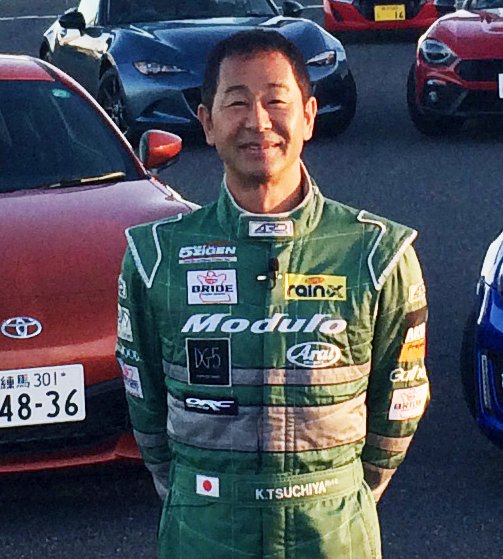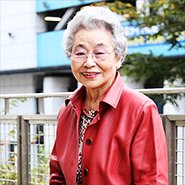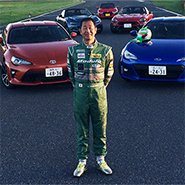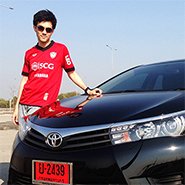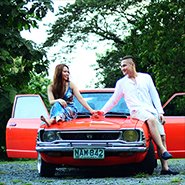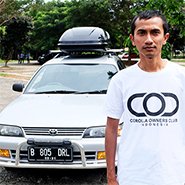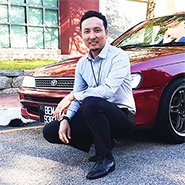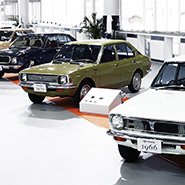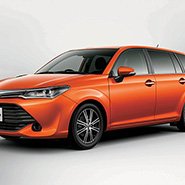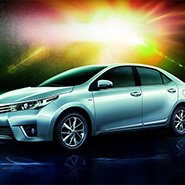Nov. 08, 2016
A Corolla, But Not An Economy Car - Why I Still Drive My AE86
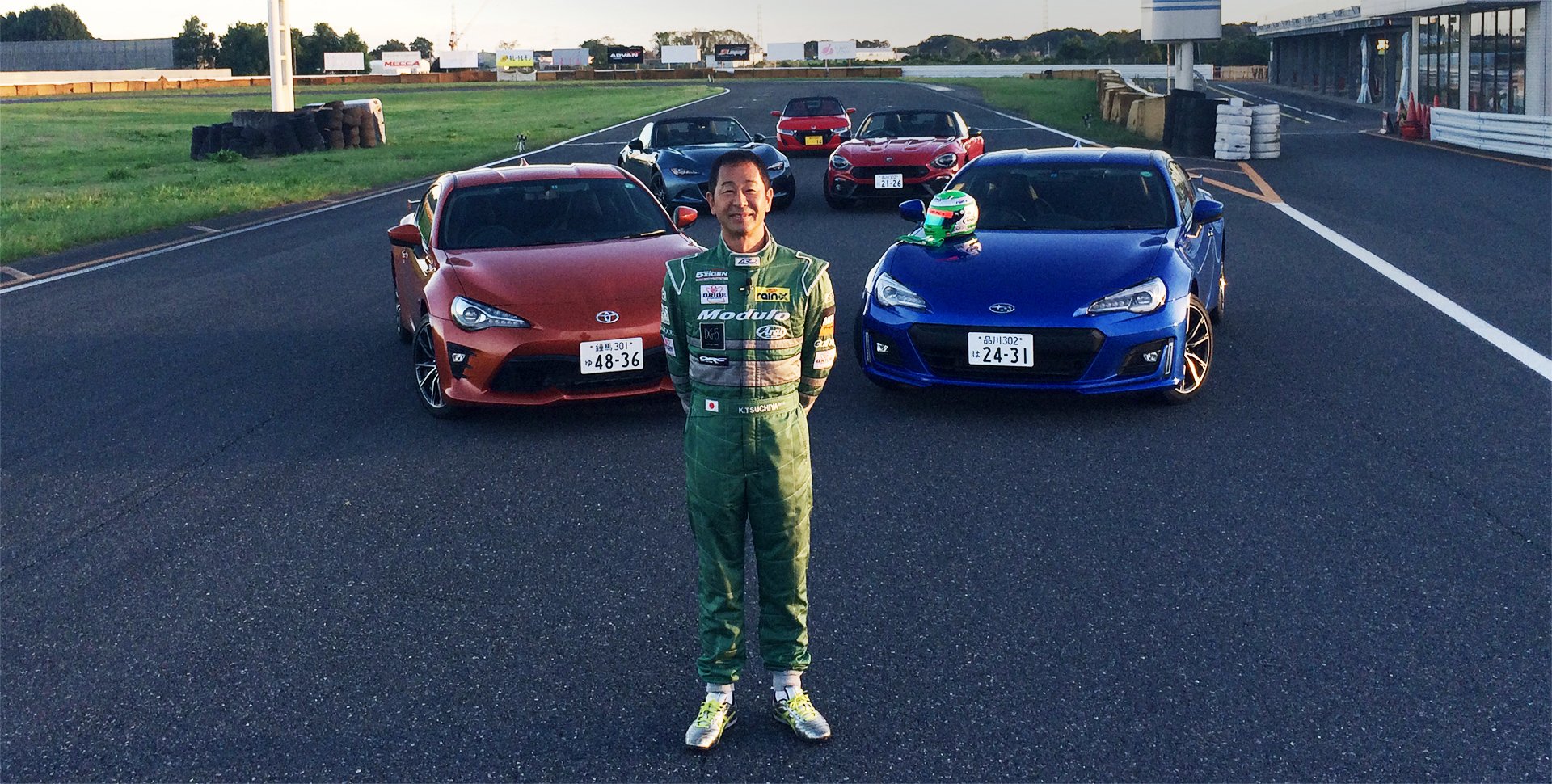

Keiichi Tsuchiya is a well-known race car driver and a 86 fan. For this segment, we talked to him about the 86, a conspicuous member of the Corolla family.
My relationship with the 86 began in 1984 at the Fuji Freshman RaceFuji Freshman RaceThe Fuji Holiday Race was held for aspiring amateurs when Fuji Speedway first opened in 1966. The name was changed to the Fuji Champion Race in 1967, and then, to the Fuji Freshman Race in 1970. The series has long been known as an event where many young drivers have kicked off a successful career in Japanese motor sports. In 1997, the name was changed back to the Fuji Champion Race.. Until then I had raced in a Nissan Sunny, and then in a Toyota KP61 StarletKP61 StarletFollowing in the footsteps of the Toyota Publica, the Publica Starlet (KP45: 1,000cc / KP47: 1,200 cc), the first-generation model, was a sporty compact car that entered the market in 1973. The Publica name was dropped from the second-generation model, known as the Toyota 1300 Starlet (commonly known as the KP61 Starlet). In the P1300 class of production cars at the Fuji Freshman Race, the Starlet was a popular rear-drive sports car racers used to replace the Nissan Sunny when the model was no longer certified.. Later, when they started up the races for the 86’s class, I really wanted to compete in it, but I couldn’t buy a race car because I didn’t have the money. At the time, Kurata JidoshaKurata JidoshaThe company sponsored a distinguished team in beginner races at motorsport events such as the Fuji Freshman Race. The team had such a good record that people began to assume that anyone who drove a Kurata Jidosha vehicle in the Freshman Race was bound to be a top-class driver. That being said, even the drivers had to work hard on that team, given that after a race, they would wash their own vehicle. They also had to wax the cars-even the parts underneath that no one could see anyway. Reportedly, the company had the drivers wash each and every bit of their vehicles so that they would know their car’s condition and understand how it was built. in Kanagawa Prefecture and Bandoh ShokaiMasaaki BandohChairman of the GT Association, which currently organizes Super GT races. He began racing when he was 20 years old. In 1983 he started up a company called Bandoh Shokai, which made a name for itself tuning race cars at the Fuji Freshman Race and other events. The company has a distinguished history in motorsport for aiding the rise of Keiichi Tsuchiya and other famous drivers like Manabu Orido and Nobuteru Taniguchi. The company’s name was later changed from Bandoh Shokai to Racing Project Bandoh. The current president of the company is Masaaki’s son, Masataka Bandoh. Racing Project Bandoh now organizes teams in both the GT500 and GT300 classes. were my sponsors, and they said that if I became the champion with the Starlet, they would then buy me an 86. Later on I was able to win the title, and in 1984, I appeared in the 86 race.
At the Fuji Freshman Race, the 86 raced at the same time as the 2-liter Nissan Skyline. I figured that a skilled driver in an 86 could beat the Skyline and its 2-liter turbocharger. Of course it was in a different class and awards were handed out separately for each, but I very much wanted to be the first driver on the track to get the checkered flag.
But when I tried, the Skylines soon passed out of sight on the straightaway, what with their two-liter turbocharged engines and all. But after I passed the first corner, the 100R corner and then the Hairpin, I could see the tail of a Skyline. From there until the last corner, the Skyline drivers couldn’t go full speed without the rear tires skidding off the track, but the 86 could get through with the pedal to the floor. So in that race I would catch up until the last corner, and then get left behind on the straightaway.
I thought if we had some rain then I might be able to win, and just then it started to rain and the track got wet. Sure enough, I flew to the head of the pack. But then the rain let up and I ended up placing second overall. I’ll never forget that time. We got complaints from NismoNismoNissan Motorsports International Co., Ltd. was established in 1984 as Nissan’s motorsports division. The company designs and sells vehicles and parts for Nissan cars in events ranging from amateur motorsport competitions to international championships overseas. At the time the team raced the R30 Skyline RS-Turbo in the NP3000B class at the Fuji Freshman Race. Due to the limited number of vehicles in the events back then, the AE86 Corolla Levin and Sprinter Trueno, which were in the NP1600D class, ran their race at the same time as the NP3000B class. and my car was completely taken apart, from the engine to the transmission. They were convinced that the only way my 86 could go so fast was because we were cheating. But of course, I was cleared when even after they disassembled the car, they didn’t find anything.
The overall placing has nothing to do with awards, and in the 86’s class I won the first six races. I won a total of eight races in the series back then, but in the final race I dropped out because the organizer, Fuji Speedway, told me not to race because if I’m in it, then the other drivers will lose their motivation!
The amazing thing about the 86 was that it had a very stiff body for its time. The alignment wouldn’t changeChange in AlignmentRefers to a change in alignment affecting the tires’ position relative to the end of the axle, a camber, a caster, a kingpin or elsewhere in the axle. Generally, when someone says the alignment has changed, that means the vehicle attitude while running has changed (such as roll, nose dive, etc.), which then causes the tires to lose traction and make the car more difficult to control. and counter-steering was quick and easy. Frankly, I was impressed. I thought, “This car is amazing.”
Another reason I drove the 86 was because I could do incredible drifting. I had drifted in the Nissan Sunny too, albeit with a low success rate. But I drove it because I thought if I could master drifting in the Sunny, then I could win races. And then I got behind the wheel of the 86. It responded perfectly to my commands, so I could make it drift perfectly. I got the nickname “Drift King” from the then editor-in-chief of “Car Boy,” an automobile magazine. That was when I was racing the 86 in the Freshman Race. He gave me the name because he thought of me as the “Drift King” when he saw me drifting in the rain around Fuji Speedway’s 100R corner while chasing a Skyline.
Later, after I won the championship at the Freshman Race, the general manager of the motor sports department at TRDTRDStands for Toyota Racing Development. As a department within Toyota Technocraft Co., Ltd. (a wholly-owned subsidiary of Toyota), this group develops and produces race cars and applies the knowledge gained through racing to manufacture and sell custom parts, tuning equipment as well as other products. and Bandoh told me they would have me race in the Japan Touring Car ChampionshipJapan Touring Car ChampionshipA popular race in Japan designated by the Federation Internationale de l’Automobile (FIA). Race vehicles were models built to carry four-plus passengers and had production of at least 5,000 units over a continuous twelve-month period (reduced to 2,500-plus units beginning in 1993). The race was divided into three classes according to displacement, although the classes raced simultaneously.. The next year, I raced in Group A. I said I wanted to race in the N2N2A one-make series for the AE86 that only lasted two years, from 1984 to 1985. Compared to the fairly normal range of modifications made in the N1, the N2 included "special touring cars" with a diversity of wide-ranging modifications to engines and suspensions, overfenders and tires, and more. It was a professional-level race whose participants included former Toyota factory drivers and pro racers., but my request was turned down because they said I was getting 10 years ahead of myself!
In Group A I raced for Tsuchiya EngineeringTsuchiya EngineeringA company established in 1971 by Haruo Tsuchiya that develops and produces race cars and racing engines. The company’s current president is Takeshi Tsuchiya, Keiichi’s son and a race car driver. Since its founding the company has been proficient at tuning Toyota engines. As Tsuchiya Engineering has had a long and close relationship with Yokohama Rubber, the company’s renowned team races under the sponsorship of Advan Color., but in every race my engine failed and I had to retire. In my final race I finally won, at Inter TECInter TECA race held at Fuji Speedway as a leg of the Japan Touring Car Championship (JTC) beginning in 1985. At the time, Victory Circle Club, which had managed numerous official races across Japan, co-sponsored the event with Fuji TV. The race’s gains in popularity led to it being added to the World Touring Car Championship, while remaining part of the JTC. At one time the event attracted over 80,000 spectators..
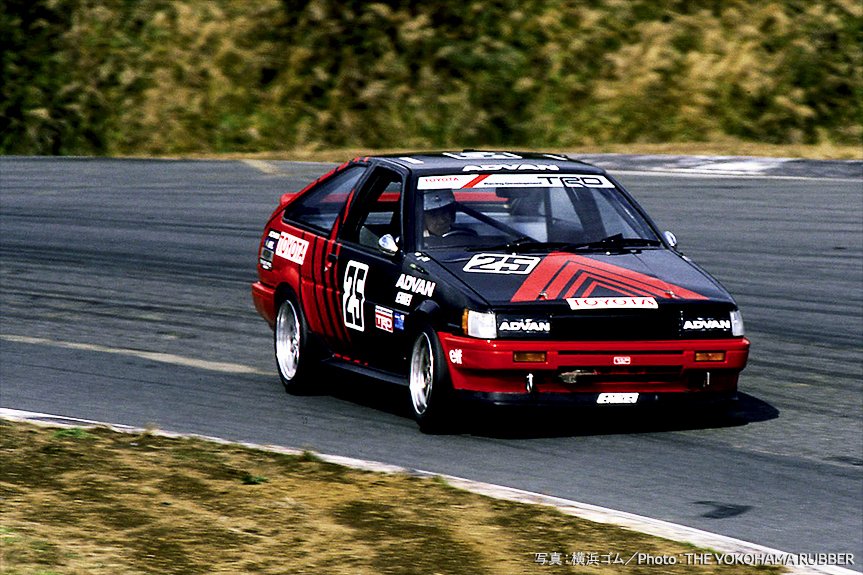
Mr. Tsuchiya racing in an AE86 at the Japan Touring Car Championship with Tsuchiya Engineering's symbolic Advan Works Color and car number “25”
Actually, I like to drive the 86 when I’m not on the racetrack as well. I bought one about half a year after it was launched, and I love it. I have owned six or seven of them since then.
Back in the day, the first time I drove the 86, it was fun. I couldn’t suppress my desire to drive it. That was also when I raced on mountain passes. But the torque was sensitive, and if it was a little off I would end up understeering. That meant I could drive it better if I stayed within the torque band, and it was interesting how the skill of the driver affected the racing performance.
I’ve raced in a lot of different cars, and in a way if you drive a good car, you become a worse driver. The ABS and electronic controls take care of a good car and cover up your mistakes. But that’s not the case with the 86. You can’t make even a single error with this car. That’s why I keep driving it. The 86 helps you become a better driver.
Another reason why I still own 86s is the aftermarket parts. Even now there are still new parts coming out somewhere, every year. I can’t let go of my 86s because it’s exciting to think about what I could do with those new parts. It is precisely because there are so many unique parts that the 86 never gets boring.

Mr. Tsuchiya races in his own “N2 Levin” at events such as the AE86 festival held in Okayama and the 86 battle at the Tsukuba Circuit
I still have a Levin and a Trueno. The Trueno is a road-taxed vehicle, and the Levin has N2 specs. Although this is the Corolla’s 50th year, I still can’t forget how amazed I was when I saw TRD’s Levin being outfitted for the N2, where before they wouldn’t let me race. Hence, as long as this kind of 86 exists, I can’t think of the Corolla as just being a family car. To be honest, I think they should have given the revived 86 the Corolla name, too.
I’m never going to get rid of my 86s. I intend to keep driving them for the rest of my life.
Keiichi Tsuchiya (Racing driver)
Mr. Tsuchiya debuted at a well-known race in Japan, the “Fuji Freshman Race”, in 1977. Since then, he participated in many race classes such as “Group A” and “F3”. At the Le Mans 24 hour race which is known as one of the world’s three most famous races, Mr. Tsuchiya joined as one of the drivers at Toyota Works in 1977, in which he received an award of the second in overall standings. He also goes by the name of the “drift king” after his original driving style of controlling turns skillfully that he showed off at the Fuji Freshman Race. Mr. Tsuchiya retired as a racing driver, and now serves as an executive adviser at a racing team “ARTA” which takes part in the “SUPER GT” race. He is also known as an enthusiastic owner of the AE86 Trueno and AE86 Levin.
